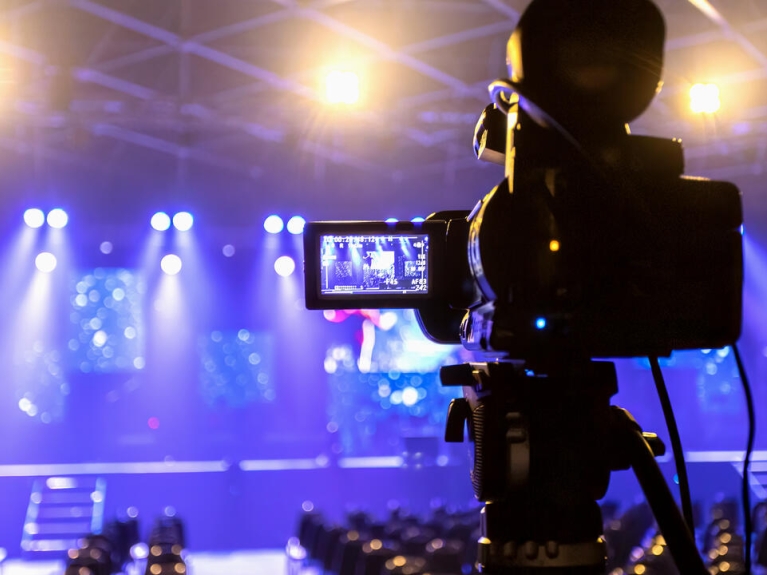Stormy Weather: The Coronavirus Pandemic’s Impact on the Music Industry

The COVID-19 pandemic is upending the entertainment industry, with music, film and television, and other industry sectors experiencing profound disruptions to the status quo. The economic and cultural effects of the pandemic may leave significant portions of the industry on the wrong side of change. In many ways, the pandemic accelerated trends that predated it. Some segments and players will be changed inalterably by the pandemic, but many may be repositioned for adaptation and potential growth when the crisis abates.
This is the second of a three-part series in which we look at the COVID-19 pandemic's impact on key sectors of the entertainment industry—film and television, music, and video games—and provide our thoughts on the likely long-term impact of the coronavirus on these sectors. In part one, we examined the film and television business; here, in part two, we focus on the music business.
The Hits Keep on Coming
Having slowly regained its footing—and profitability—following the lean years of the peer-to-peer file sharing era, the music industry again finds itself in an existential crisis, this time due to the COVID-19 pandemic. In response to the virus, and specifically to stay-at-home orders and the likelihood of long-lasting restrictions on large gatherings, live event organizers have been cancelling or postponing concerts, tours, and other music events, leading to financial hardships not just for artists, but for an entire $12.2 billion dollar ecosystem built around such events. Music festivals often serve as major revenue sources for local economies, and cancellations can have a devastating impact not just on the artists and organizers, but also on smaller businesses, such as hotels and restaurants, and even the host cities themselves that benefit greatly from spikes in business during these events. SXSW, for example, brings in an estimated $356 million to the city of Austin, not just to presenters and artists. Music venues, dance clubs, and brick-and-mortar music shops are also struggling to pay rent and staff wages; many may never reopen.
While the in-person live music business experiences turmoil, there are some glimmers of hope for the industry at large. For example, the New York Times recently reported that consumer spending on music streaming has increased significantly this year. Spotify reported that monthly active users for its service increased by 31% in the first quarter of 2020. Warner Music Group's first-quarter numbers show that, despite revenue declines in physical music sales, streaming revenue grew 11%, up by $49 million on the equivalent figure from the first quarter of 2019. Twitch, a livestream platform best known as a space for gamers, has seen musicians, unable to tour during the pandemic, flock to its platform to stream live performances; the company has experienced a jump in viewership of its Music and Performing Arts category of streams from 92,000 average viewers to 574,000 average viewers in the period from March 8 through March 22, 2020. Some streaming services have offered free access to their otherwise paid services for a limited time. For example, SiriusXM has offered free access to all of its ad-free music channels for a limited time.
Music tastes are being reshaped by the pandemic. For example, in one week in March, streams within the United States of the top 200 songs on at least one major music platform fell by nearly 14 million from the prior week and this metric continued to decline in following weeks. Spotify noted that its listeners are seeking more chill music, adding songs to their playlists that are "more acoustic, less danceable, and have lower energy." The Wall Street Journal reports that online listeners are shunning contemporary pop for "old favorites" and "comfort music" from classic artists such as Bob Marley, Bob Dylan, the Dixie Chicks, and Bill Withers (whose recent death has not been linked to COVID-19).
Music habits are also changing. Spotify has observed an increase in collaborative playlists and in sharing from its platform to social networks, indicating that people are still finding ways to connect through music during the pandemic. A study of Primephonic, a music streaming service for classical music, has revealed that, during the lockdown, consumers have adjusted their listening schedules, logging fewer morning sessions (which presumably occurred pre-pandemic during morning routines and commutes) but participating in more listening sessions spread throughout the day. Although possibly driven as much by news as music, many radio stations are experiencing a boom in listeners, with the BBC reporting an 18% increase in the streaming of its radio stations over a single March week.
In another bright spot, the industry is adapting quickly to bring live music to fans via online concerts across a variety of genres that can be streamed via Facebook Live, YouTube, Twitch, and other online platforms. On April 18, the "One World: Together At Home" concert, organized by Lady Gaga to honor healthcare providers and encourage social distancing, aired across 30 networks to 20.7 million viewers, raising $127 million to fight the coronavirus. Even DJs, who thrive on the energy of a live audience, have embraced streaming platforms, sometimes asking viewers for donations to charitable organizations. One initiative, United We Stream, has been broadcasting nightly DJ sets from clubs in Berlin, racking up six million views and raising over 400,000 euros to support ailing clubs. Timbaland and Swizz Beatz have been bringing major hip hop and R&B artists to Instagram Live through a series called Verzuz, where artists like T-Pain and Lil John play their greatest hits and compete for votes from a live audience. And virtual concerts—in which artists perform via their avatars within online video games or other immersive digital environments—are beginning to attract large virtual audiences.
But DJs and musicians more dependent on live audiences, like the estimated 5,000 musicians who make up New Orleans' legendary music scene, are still straining for ways to make a living during the pandemic, with many turning to unemployment insurance and informal assistance networks where possible. Spotify has rolled out a new feature that allows artists to highlight a fundraising campaign on their artist profile to support themselves, their bands, or their crew. In other positive news, Amazon Music, Facebook, SiriusXM, Pandora, Spotify, Tidal, and YouTube Music have donated to a relief fund created by MusiCares to support music workers whose livelihoods have been affected by the pandemic. Bandcamp has implemented periods during which it waives fees for musicians using its online streaming and e-commerce platform. Billboard has compiled a list of national and state resources to help music professionals, which includes more than four dozen relief funds.
While webcasted live performances have become ubiquitous, the recording of new music has understandably taken a hit, with artists and producers unable to collaborate in person and opting instead to delay their production schedules. Because artists, especially independent ones, have become increasingly dependent on touring revenue, many have opted to postpone releases until they can coincide with live shows.
That being said, some artists have embraced self-isolation in their music, either in obvious ways, like Drake donning a face covering in his latest music video, or more subtly by releasing TikTok-friendly music. Notably, use of TikTok has boomed, with one estimate indicating nearly a 20% increase in downloads during a one-week period in March. While many artists, including Lady Gaga, HAIM, and Luke Bryan, have delayed album releases due to the pandemic, music fans can look forward to a massive post-pandemic release schedule, when the recorded music floodgates will open. Of course, that flood of new music has its own perils as those new recordings compete for attention in a field that is more crowded than usual.
Better yet, some artists and labels are charging full speed ahead with releases, perhaps capitalizing on fans having more flexible schedules to listen to music. Instead of the usual promotional interviews and performances on late night shows, Dua Lipa released her album at the end of March, accompanied by a YouTube livestream of her playing and commenting on the new songs. In a major surprise, just two months after dropping his sophomore album in March, Bad Bunny released another new album in early May that includes En Casita, a song all about the frustrations of being stuck at home during the pandemic together with a number of songs that the artist had previewed on Instagram Live. And Fiona Apple released her long-awaited new album during the lockdown, to great critical acclaim (Slate has dubbed it "the unofficial album of the pandemic").
Despite positive developments here and there, however, the overall industry mood is gloomy. Particularly sobering is the number of iconic, beloved musicians, such as John Prine, Ellis Marsalis, and Adam Schlesinger, among others, who have died due to COVID-19.
Predictions
We anticipate the following industry developments arising out of the pandemic:
- More than any other sector of the entertainment industry (other than perhaps sports), music is all about the live experience and the pandemic will not change that fact. As Dave Grohl of the Foo Fighters penned in a recent op-ed for The Atlantic, "There is nothing like the energy and atmosphere of live music . . . . I don't know when it will be safe to return to singing arm in arm at the top of our lungs, hearts racing, bodies moving, souls bursting with life. But I do know that we will do it again, because we have to." But until that day arrives, expect to see an ongoing, accelerating shift toward virtual events and greater online engagement between fans and artists, developments likely to remain a part of the industry landscape even after the pandemic subsides.
- With tours unlikely to return any time soon, artists may have to find new monetization opportunities, possibly by relying more on advertising revenue, subscription models, merchandising, virtual tip jars, and even online music lessons.
- When concerts and other live events slowly begin to return, until a coronavirus vaccine is developed, audiences will be much smaller, and promoters and venues will need to implement expensive, cumbersome measures to keep performers and fans safe and healthy. And expect to see the rise of "drive-in concerts," in which fans watch their favorite bands from the safety of their cars.
- With a historic spike in unemployment, cash-strapped consumers who had been increasingly embracing paid subscription streaming services in recent years may return to free or "freemium" ad-supported services, or even pirated music shared over peer-to-peer file sharing networks.
- Further consolidation within the music industry seems likely, especially among music publishers and among concert promoters and venues—sectors of the industry with a large number of small players that are ripe for a roll-up.
- Pre-pandemic, the music industry was already in the midst of a massive transformation, with the explosive growth of streaming services, the rise of artist services platforms, a blurring of the lines that traditionally separated content producers from content distributors, and the emergence of disruptive technologies such as music-creating AI algorithms. The pandemic is likely to add fuel to these trends as old ways are abandoned and new business models and opportunities are embraced.
- Indeed, look for further industry convergence and obliteration of traditional sector boundaries as companies that are thriving despite the pandemic find attractive buying opportunities among established companies struggling to stay above water, despite good business fundamentals and among early-stage start-ups with business models that are uniquely situated to appeal consumers in a shelter-at-home world (such as virtual concert or live internet radio platforms). Throughout the history of the music business, we've distinguished between content creators and content distributors—will that distinction continue to remain relevant as the industry reshapes itself in the wake of the pandemic?
Concluding Thoughts
As with the film and television industry, the music business is experiencing an accelerated pace of change and disruption due to the coronavirus pandemic. Sectors that were struggling pre-pandemic will become weaker still, while the sectors that were already benefitting from the shift to digital may be well positioned to experience even greater growth. Having weathered the rise of radio, home taping, the internet, and even the peer-to-peer file sharing revolution, the music industry will survive the current pandemic as well (as it did the 1918 Spanish flu pandemic)—but it will be a transformed industry, and, sadly, many beloved institutions and traditions may be left behind.
* * *
This is part two of a three-part series on the pandemic's impact on the entertainment industry. Part one, covering the film and television industry, can be found here; part three, which will focus on video games, will be published shortly.
© 2020 Perkins Coie LLP


